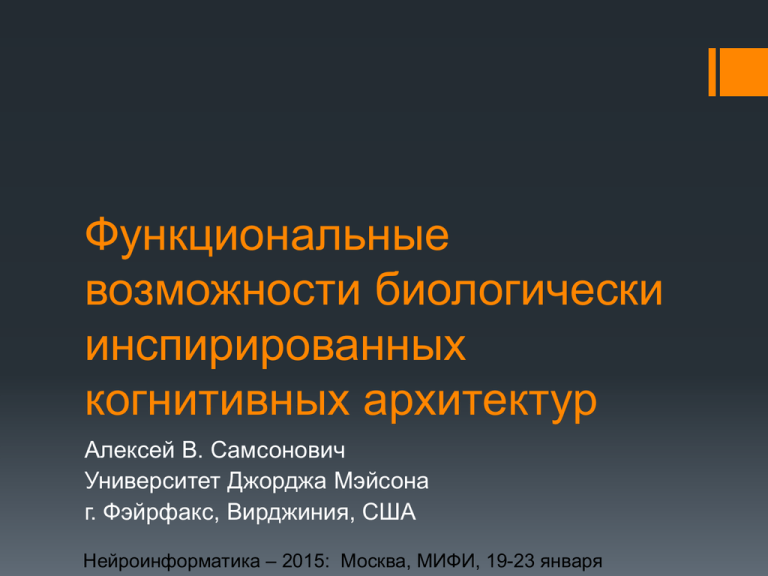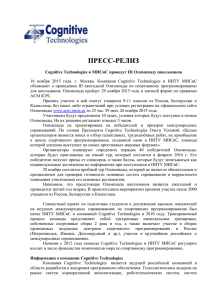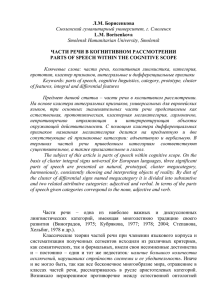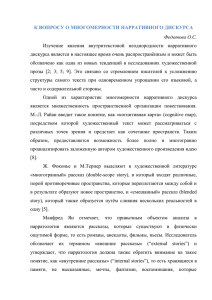Функциональные возможности биологически инспирированных
advertisement

Функциональные возможности биологически инспирированных когнитивных архитектур Алексей В. Самсонович Университет Джорджа Мэйсона г. Фэйрфакс, Вирджиния, США Нейроинформатика – 2015: Москва, МИФИ, 19-23 января Функциональные возможности биологически инспирированных когнитивных архитектур Аннотация: Основные функциональные аспекты мышления человека можно описать на вычислительном уровне и воспроизвести в машине на принципах не требующих детального моделирования нейронов и структур мозга. Это прежде всего основные принципы восприятия и осмысления информации, принятия и исполнения решений, сформулированные на языке символьных моделей типа когнитивных архитектур. Ключевыми же являются принципы социальноэмоционального интеллекта, нарративного интеллекта, мета-мышления, автономного выбора целей, семантического картирования, человекоподобной обучаемости и креативности. Создание в машине аналога человеческого субъекта на этих принципах и признание его людьми на уровне равного человеку персонажа приведет к технологическому прорыву, который окажет влияние на все сферы жизни человека. Ключевые слова: когнитивные архитектуры; нарративный интеллект; социально-эмоциональное мышление Четыре научных направления сводящиеся к одной задаче: Вычислительная нейронаука Когнитивное моделирование • Goal: Parsimoniously explain in detail how the brain works, Reverse-engineer the brain • Goal: describe computationally, and be able to predict in detail, human behavior and underlying cognitive processes Искусственный интеллект Машинное сознание • Goal: Develop a practically useful artificial intelligence that will replace and outperform humans in a broad spectrum of valuable cognitive tasks • Goal: Generally “conscious” artifacts capable of becoming useful members of the human society Четыре разрыва в возможностях и подходах Разрыв в понимании процессов лежащих в основе мышления на высшем и на элементарном уровне Разрыв между искусственным и естественным интеллектом Разрыв между железом и ПО Разрыв между ролью человека и искусственного интеллектуального агента Разрыв в вычислительных подходах: • • • • Logical circuits, control systems (cybernetics) Nonlinear dynamical systems, self-organization Models of neurons and their parts Neuronal networks (connectionism) • GAP • • • • • Cognitive neuropsychological models of agency, etc. Symbolic modeling Modal logic, event calculus, etc. Expert systems, automated reasoners & planners Intelligent agents, virtual characters, social modeling Возможно интересный взгляд: Для моделирования когнитивных функций человеческого мозга не требуется нейронный уровень Когнитивные карты – одна из основ интеллекта Биологически инспнрнрованные когнитивные архитектуры (BICA) выступают как объединяющая парадигма требующая комплексного подхода Ключевыми являются принципы социальноэмоционального и нарративного интеллекта (включая мета-мышление, автономный выбор целей, …), и человекоподобная обучаемость Почему недостаточны модели на уровне отдельных нейронов? Почему недостаточны модели на уровне отдельных нейронов? Wire diagram of the visual system Hierarchy of the visual areas in the brain of a macaque monkey. From: Felleman, D.J. and Van Essen, D.C. (1991) Hippocampal connectivity diagram Почему недостаточны модели на уровне отдельных нейронов? A Large-Scale Model of the Functioning Brain Chris Eliasmith, Terrence C. Stewart, Xuan Choo, Trevor Bekolay, Travis DeWolf, Yichuan Tang, Daniel Rasmussen. Science 30 November 2012: Vol. 338 no. 6111 pp. 1202-1205 DOI: 10.1126/science.1225266 Что нужно для преодоления разрыва? Corresponding elements: Levels of paradigms in understanding intelligence: • Psychic and social phenomena • Cognitive psychological models • … • Computational neuroscience • ‘Black box’ AI higher cognitive models The Self Personality Values… GAP Neurons Synapses Neural networks Patterns… Environment BICA Levels of paradigms in understanding intelligence: • Psychic and social phenomena • Cognitive psychological models • Brain-based cognitive modeling • Computational neuroscience • ‘Black box’ AI Corresponding elements: higher cognitive models The Self Personality Values… Mental states Schemas Frames Rules Chunks Concepts… Neurons Synapses Neural networks Patterns… Environment Пример: пространственная когнитивная карта Пример: пространственная когнитивная карта The concept Activity packet representation of experimental data (from Samsonovich & McNaughton,1997) Head-direction cells Пример: клетки решётки (grid cells) • From Fyhn et al. Nature 2007 Пример: клетки решётки (grid cells) McNaughton, B. L., Battaglia, F. P., Jensen, O., Moser, E. I., & Moser, M. B. (2006). Path integration and the neural basis of the "cognitive map". Nature Reviews Neuroscience 7 (8): 663-678. Пример: клетки решётки (grid cells) Пример: семантическое картирование Semantic mapping approaches Algebraic Graph-based Formal Continuous metrics Ad Hoc Strong maps (LSA, HAL, Eigenwords, MDS, Isomaps, etc.) Corpus-based Description FOL, Modal Logics Logics, Etc. Lexical, Ontologies Semantic Nets, Formal Concept Frames Analysis, Symmetric Conceptual Graphs GMU WSM Weak maps Human Rankings Asymmetric (is-a, has-a) Laplacian Laplacian embedding Laplacian embedding Emotion spaces (Russell 1980) Plutchik Cube of emotions (Lövheim 2012) Other well-known models include: • PAD (ANEW) • EPA • Semantic differential 20 Weak semantic map of emotional words 21 FROM: Thomas Naselaris, Dustin E. Stansbury b, Jack L. Gallant (2012). Cortical representation of animate and inanimate objects in complex natural scenes. Journal of Physiology. BICA: definitions • A cognitive architecture is a computational framework for designing intelligent agents. • An agent, or actor, is a cognitive system embedded (not necessarily embodied) in a physical or virtual environment, such that it can perceive information and perform actions to satisfy its needs. • A cognitive system is an information-processing dynamical system whose elements are functionally related to the semantics of the processed information. Basic cognitive cycle of a cognitive architecture Actor Cognition: Reasoning, deliberation, decision making Model representations in working memory Current state Goal state (candidate) actions Expected state Perception Action Input Output Environment, including the actor’s body and other actors Hierarchy of cognitive architecture types Architecture type and level The agent is capable of Metacognitive and selfaware (highest) Modeling mental states of agents, including own mental states, based on a self concept Reflective (high) Modeling internally the environment and behavior of entities in it Proactive, or deliberative (middle) Reasoning, planning, exploration and decision making Reactive, or adaptive (low) Sub-cognitive forms of learning and adaptation Reflexive (lowest) Pre-programmed behavioral responses Generic template for extended cognitive architectures Emotion: Working memory Metacognition: Working memory Imagery: Working memory Knowledge: Semantic memory 1st order cognition: Working memory Narrative (goals, plans, experiences): Episodic memory Skills: Procedural memory Perception and action: Sensorymotor memory (Interface, I/O) Drives, values: Value system Agent’s body, other objects and agents: Environment Generic goal reasoning model inspired by the OODA loop Decide Orient Plan Recognizer Response Selector Info Info Gathering Info Gathering Response Simulator Expectation Fuser State Predictor Goal Goal Formulator Transform. Event Detector Event Diagnoser Plan Generator Plan Analyzer Actor 1 Gatherer 1 Goal Prioritizer Goal Selector Plan Selector Goal Manager Initial Goal Internal Models Operator Interface plan observations Observe Act actions percepts Execution Environment Operator Initial State Definitions and formalization • The purpose of goal reasoning is to optimize the working narrative on the given cognitive map, following certain rules and policies. This can be done using a metacognitive cycle operating on the cognitive map, similarly to the base cognitive cycle operating on the working memory representation of the current state and the current goal. • Goal reasoning cycle • Operates on cognitive map • Triggered by notable phenomena – – – – – Detect notable phenomena that require attention Update states based on notable phenomena Update and re-evaluate narratives Select the working narrative and identify the current goal in it Return to basic cognitive cycle Compare with: formulated selected expanded committed dispatched evaluated finished Specific example: drive-driven desire-based goal activation Binding Value System Desires Values (Mission) Current Actual State Current Expected State Current Goal Agitation Planner and Controller Perception Stimulus Monitor Ground-Level Architecture Input Drives Action Environment (Simulator), Including Other Actors Human Instructions Metacognitive Goal-Reasoning Component Goal Manager Relevant Causes Previous Previous Previous States States States Current Actual State Notable Event Detector Working Working Roadmap Scenario Scenario Metareasoner Current Expected State Current Goal Planner and Controller Perception Ground-Level Architecture Potential Potential Potential Goals Goals (New) Goals Input Action Environment (Simulator), Including Other Actors Metacognitive Goal-Reasoning Component Goal Manager Relevant Causes Potential Potential Potential Goals Goals (New) Goals Value System Binding Notable Event Detector Working Working Roadmap Scenario Scenario Desires Previous Previous Previous States States States Current Actual State Metareasoner Current Expected State Mission Values Current Goal Agitation Planner and Controller Perception Stimulus Monitor Ground-Level Architecture Input Drives Action Environment (Simulator), Including Other Actors Human Instructions Нарративный интеллект Уровень автора • Нарратив: – фабула, сюжет Уровень актёра • Нарративное планирование • Нарративное целеполагание A: “fabula” Call colleague Friend invites to a birthday party Decide on the strategy Reschedule meeting no Go to the meeting yes Go to the party ? Drive to a store yes Buy present Go home no B: “sjuzet” Friend calls Decide on the strategy Drive to a store Call colleague Reschedule meeting Buy present Go to the party Возможные применения BICA 1. 2. 3. 4. 5. Emotionally intelligent social agents Narrative-intelligent autonomous agents Human-level learning agents Fast & secure authentication system BICA for elderly people and people with disabilities 6. BICA for artificial creativity Искусственная креативность? Fluid intelligence test BICA model solving a test for fluid intelligence Четыре научных направления сводящиеся к одной задаче, и почему каждое из них само по себе не достаточно Разрыв между искусственным и естественным интеллектом Разрыв между железом и ПО Разрыв в понимании процессов лежащих в основе мышления Новая теоретическая парадигма объединяющая два уровня Почему не нужен уровень отдельных нейронов? Пример: пространственное мышление Пример: семантическое картирование Комплексный подход: Основа, Расширенные возможности Иерархия когнитивных архитектур Приложения социальные агенты эмоциональный, нарративный, обучаемый интеллект надёжная аутентификация помощь престарелым и людям с ограниченными возможностями искусственное творчество Научное общество BICA Society: миссия координации усилий, конференция, журнал, видеопанели, таблица Научное общество BICA Society – Activities : • • • • The conference The journal BICA Videopanels Online Comparative Repository of Cognitive Architectures Выводы: Для моделирования когнитивных функций человеческого мозга не требуется нейронный уровень Когнитивные карты – одна из основ интеллекта Биологически инспнрнрованные когнитивные архитектуры (BICA) выступают как объединяющая парадигма требующая комплексного подхода Ключевыми являются принципы социальноэмоционального и нарративного интеллекта (включая мета-мышление, автономный выбор целей, …), и человекоподобная обучаемость


